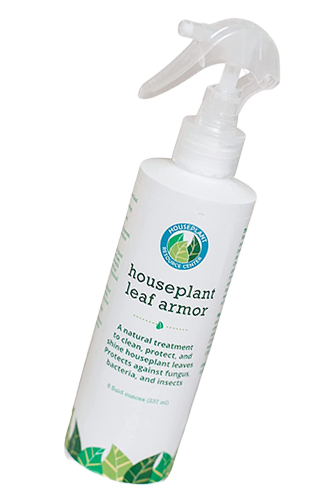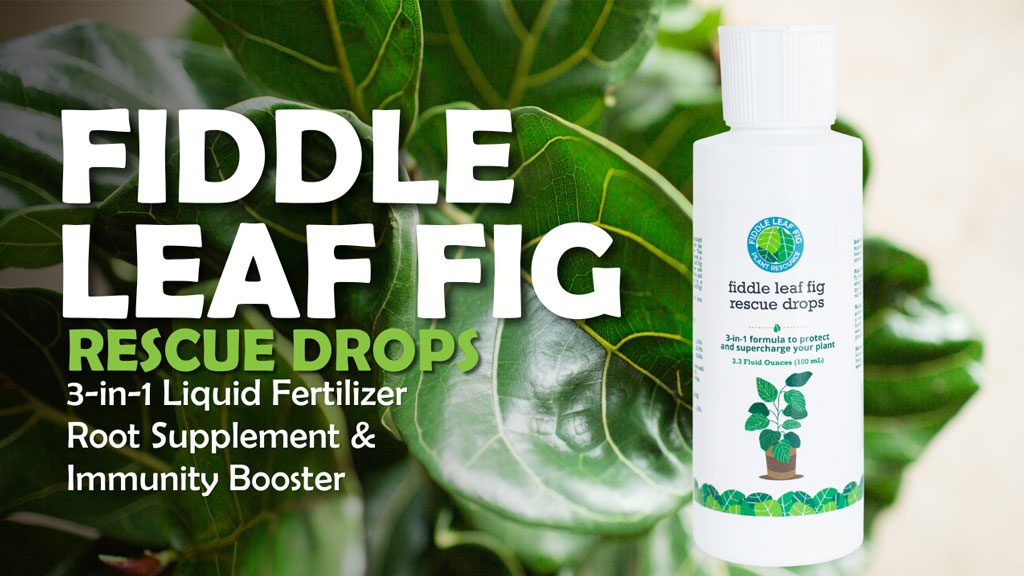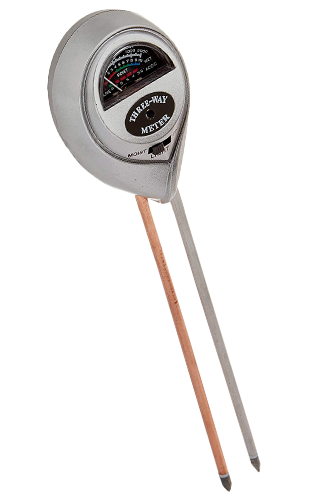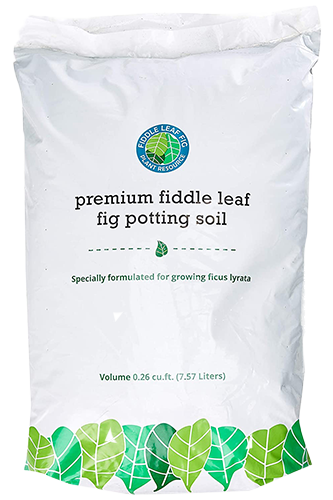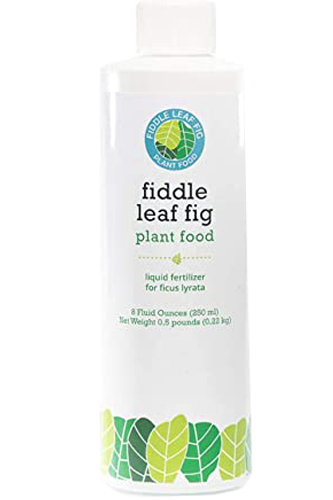Bacterial Infections in Fiddle Leaf Figs
One of the first signs of problems in fiddle leaf figs is brown spots, but brown spots can mean a lot of different things. They could indicate dryness or sun damage, insect infestation, or, in rare cases, fungal or bacterial infections in fiddle leaf figs.
In previous articles, we’ve discussed fungal infections and how they can impact the health of your fiddle leaf fig. They can range from blight to root rot and are major challenges to indoor plant growers. But what about bacterial plant infections?
Bacterial infections in fiddle leaf figs aren’t common, but they do happen and they can wipe out your plant and even spread to other houseplants if you don’t act quickly.
Plant infections can arise from dirty hands, tools, other plants, etc. They can manifest not only as brown spots but also in the stems and roots of the plant. Root rot is an infection of a plant’s root system that can be caused by both bacteria and fungi, with fungi being the most common culprit in fiddle leaf figs. If you suspect root rot and the soil isn’t overly wet or if your plant doesn’t respond to root rot treatment, it could be a bacterial infection.
How to Recognize Bacterial Infections in Fiddle Leaf Figs
Bacterial infections in fiddle leaf figs can be difficult to differentiate from root rot symptoms, but there are some key differences.
Brown spots ranging from tan to dark brown
Spots from root rot are typically dark brown or even black. If the spots are a lighter brown or even tan, it could be bacteria.
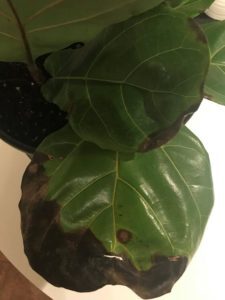
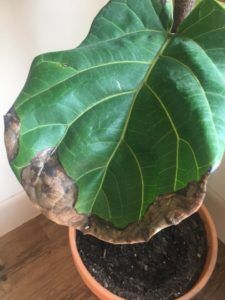
For more information on brown spots, read What Causes Brown Spots on Fiddle Leaf Fig Leaves? (And How to Treat Them Quickly) here.
Yellowing leaves
In cases of root rot, the leaves will stay dark green with dark spots. With a bacterial infection, the affected leaves may yellow, especially right around the spots.
Multiple spots in a single leaf
Bacterial infection will cause spots across the leaf as well as on the edges, whereas spots from root rot typically occur along the edges of the leaf or spread from the stem.
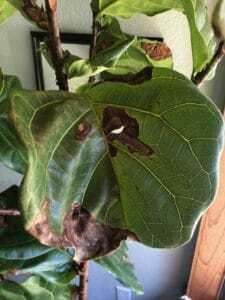
Leaves affected all over the tree
Root rot tends to affect the bottom leaves first while bacterial spots can show up all over the tree. You may also notice that the newer leaves are affected more because they may be more vulnerable to infection.

How to Prevent Bacterial Infections in Fiddle Leaf Figs
As with any disease, prevention is the best mode of action. Here’s how to protect your plant before the problem starts.
Check your plant and its neighbors before you buy.
Many bacterial infections start in the nursery and come home when you buy a plant, where it can infect your other plants!
When you buy a plant from the nursery (any plant, not just a fiddle) check for signs of infection, but also be mindful of how healthy the other plants look.
If the plant you’re considering looks healthy while the others show yellowing and brown spots, you might want to look elsewhere.
Keep your plants clean.
Just like with contagious diseases that affect humans, we want to prevent the spread of bacteria, and cleanliness helps. Use clean hands, clean tools, and clean pots when dealing with your plants. Use clean tools when pruning, notching, or pinching. Clean out your pots before potting a new plant.
- Pro Tip: To disinfect pots, soak them in a solution containing one part household bleach to 9 parts water for a minimum of 10 minutes, then rinse. To clean clay pots, use steel wool or a wire-bristle brush to remove mineral deposits and other debris that may harbor pathogenic organisms. Make sure pots are thoroughly rinsed before repotting.
Don’t over-water.
Another reason to avoid over-watering! Bacteria can spread and thrive in overly wet conditions and can actually spread through water, especially if you get the leaves wet. Read our Ultimate Watering Guide here.
Air circulation.
Prune dense areas and avoid packing your plants too close together where air can’t flow and bacteria can spread easily. A gentle fan is also a good idea to keep air moving in your home.
Don’t touch the leaves more than you have to.
When you do touch your plant, wash your hands first. Be aware of children and pets who may touch the leaves and spread bacteria. You can’t always prevent that, but it’s something to be mindful of.
Watch for symptoms in your other plants.
If you notice signs of bacterial infection in any of your plants, get it away from your other plants and treat the problem! As mentioned above, this is especially true when purchasing new plants from a big-box store or nursery. We recommend our Houseplant Leaf Armor, designed to protect your plant from bacteria, fungus, and insects. As an added bonus, it also cleans and adds shine to your plant’s leaves!
Be careful with overhead watering methods like misting or showering.
I’m not saying showering is bad, but keep a close eye on your tree and keep in mind that bacteria can spread that way. If you’re simply watering your tree, water only the soil and avoid getting water on the leaves.
Avoid using old or questionable potting mix.
Bacteria can grow and spread in soil, so don’t use a potting mix that’s been sitting in your shed for years or if it looks at all questionable. If you see mold, strange discoloration, or if it smells funky, throw it out and get a fresh bag. We recommend our Premium Fiddle Leaf Fig Potting Soil.
Keep the surface of the soil clean.
Clear the soil surface of dropped leaves, dust, debris, or any other objects that shouldn’t be there. This gives bacteria and fungi fewer areas to grow near your plant.
How to Treat Bacterial Infections in Fiddle Leaf Figs
Bacterial infection can be tricky to treat. Once it takes hold, you might be fighting a losing battle. If you catch it early on though, your plant may stand a chance!
Have you ruled out a fungal infection first?
Root rot is a common ailment of fiddle leaf figs and one of the most common causes of brown spots on leaves. Before taking drastic action, you might want to first try a root supplement that provides an immune boost to your plant.
Remove the affected leaves to prevent spreading.
This might shock your plant, and isn’t typically recommended, but if you catch it early enough, your plant may make a full recovery. (Be sure to use sharp pruning shears like these.)
Repot the plant in fresh soil using a clean pot.
Gently clean as much of the old soil out of the root ball as you can. This will decrease the probability of transferring any bad bacteria from the old soil to your fresh clean pot. Read How to Repot a Fiddle Leaf Fig Tree here.
Make sure it gets plenty of light.
Your plant is fighting off a disease, so make sure it gets lots of energy from bright, indirect sunlight to help it recover after pruning and repotting.
Go easy on the water.
Bacteria can spread in the water, so keep it to a minimum while your plant is recovering. Don’t let your plant dry out, but over-watering can be far more dangerous in this case. Read our Ultimate Watering Guide here.
Don’t mist or shower.
Bacteria can drip from one leaf to others, so don’t let the leaves get wet during this time. Infected lesions exude bacteria that are easily splashed from leaf to leaf. These bacteria gain access into the leaves of the fiddle leaf fig via stomatal openings.
Bactericides containing copper compounds are sometimes used to control bacterial diseases. The response may vary depending on the type of infection.
Is it too late?
If more than half the plant is affected, it’s probably too late to save it. This is a sign that the bacteria is spreading too rapidly for you to help it.
Removing the leaves would cause extreme shock to the plant, and likely kill it anyway. Time to wave the white flag and start over with a healthy plant.
Bacterial infection is every plant owner’s nightmare, but it can be prevented and even treated if you catch it early enough.
Monitor your plants closely, maintain good care techniques, and keep them clean to prevent the spread of bacteria. If you’re lucky, you may never have to deal with bacterial infections in fiddle leaf figs at all!
Grab the Essentials for Your Fiddle Leaf Fig:
- Premium Fiddle Leaf Fig Potting Soil
- Fiddle Leaf Fig Plant Food
- Root Rot Treatment
- Houseplant Leaf Armor to protect against insects, bacteria, and fungus (As an added bonus, it also cleans and adds shine to your plant’s leaves!)
- Moisture meter to always know when your plant is thirsty.
To learn more:
- To learn more, sign up for our free Fiddle Leaf Fig Care 101 Webinar or enroll in our free Fiddle Leaf Fig Course for advanced fiddle leaf fig care.
- Make sure you’re subscribed to our newsletter.
- Read The Fiddle Leaf Fig Expert, your complete guide to growing healthy fiddle leaf fig plants. The book is available in full-color paperback or Kindle edition on Amazon now!
- Click to join our community on Facebook: Fiddle Leaf Fig Plant Resource Group.


